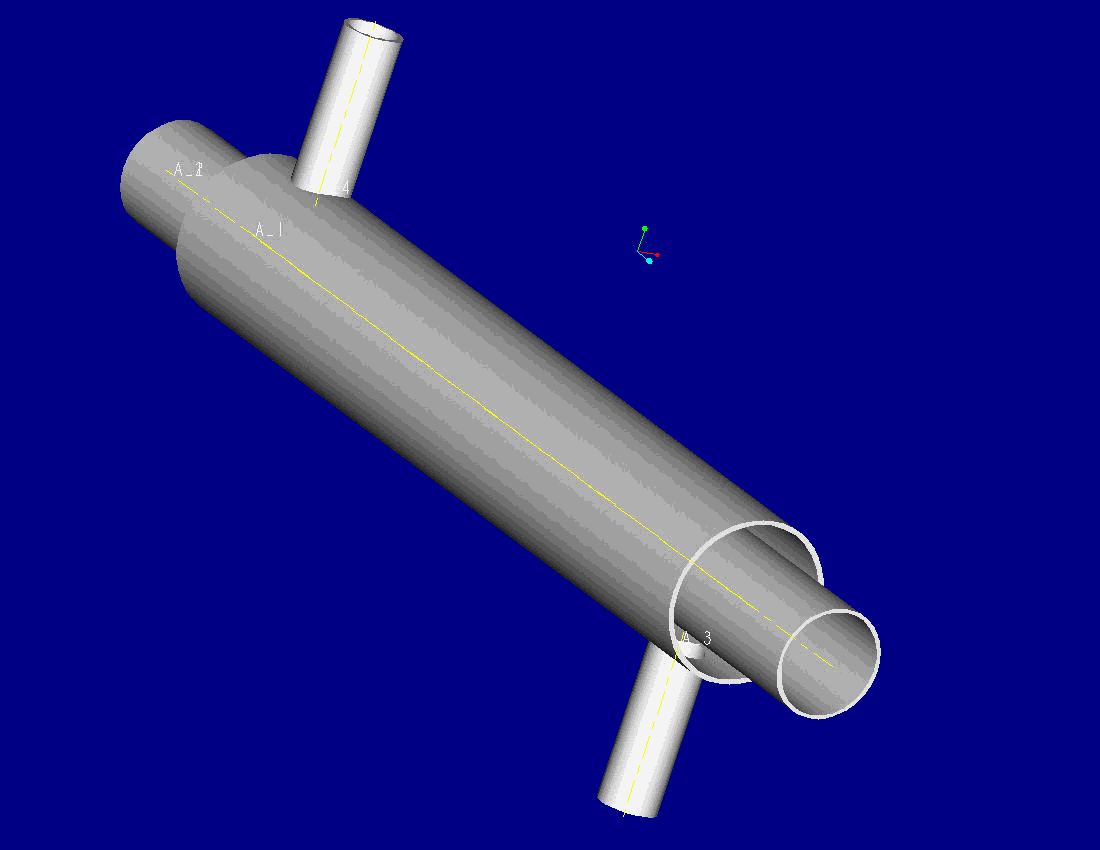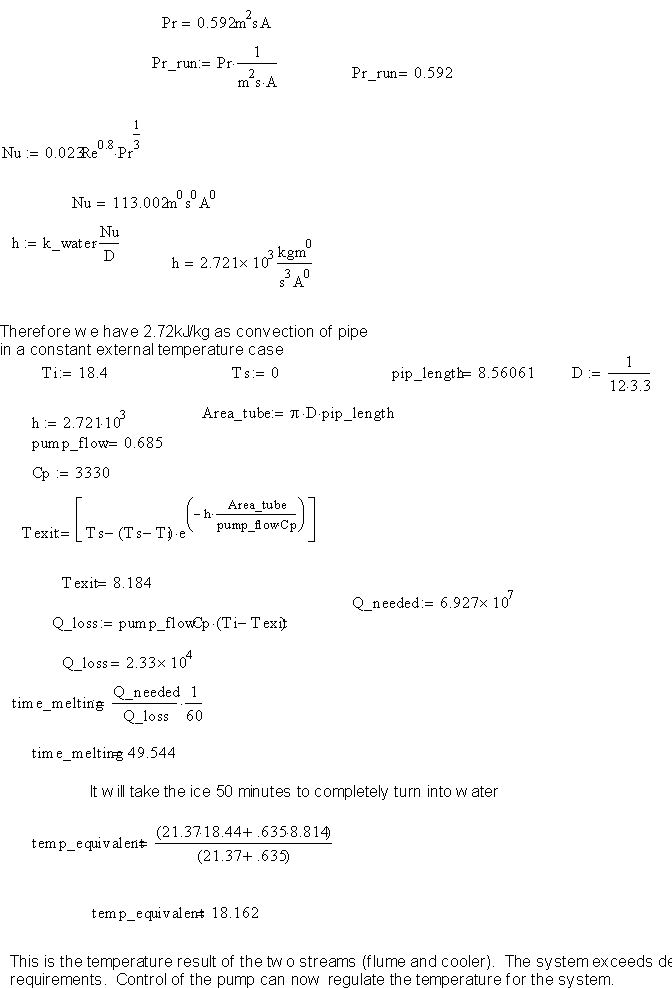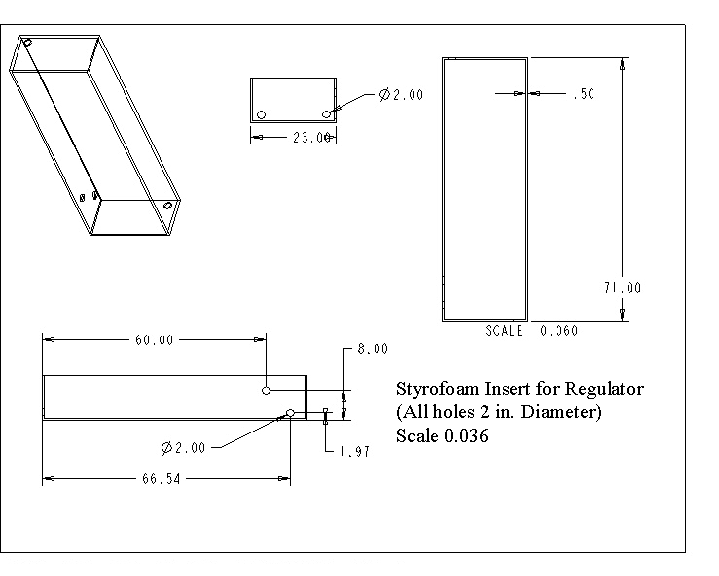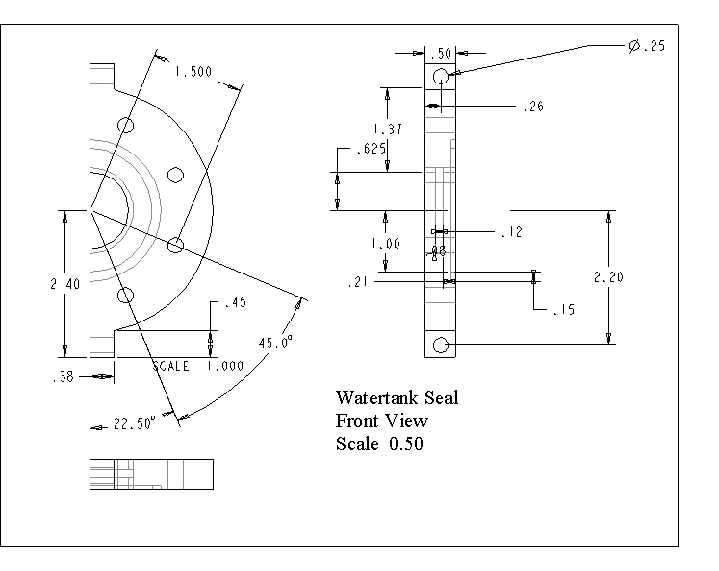 Back
to Fall Reports
Back
to Fall Reports
Saltwater Flume Project:
Final Report
EML 4551C: Senior Design Project
Dr. Luongo Instruct.
Dr. Thistle Client
11/30/2000
Coastline Research Inc.
Design Team 10
Takenya Williams
Ivan Lee
Arnett Flowers
1.0. Introduction
2.0. Customer Needs Assessment
3.0. Preliminary Design Specifications
3.1. Design
Team Specifications
3.2. First
Design Concept
3.3. Second
Design Concept
3.4. Third
Design Concept
4.0. Final Design Concept
5.0. Conclusion
Appendix A
Appendix
B
Appendix
C
Temperature changes can be a major cause of error in an experiment. They can cause data readings to be slightly off and inconsistent, which is the case with the salt water flume at the Florida State University (FSU) Marine Laboratory. A temperature regulator is needed to solve the problem completely, and eliminate any error caused by temperature changes.

Figure 1.1: Water Flume
The design for the temperature regulator of the salt water flume begins with the basic flume itself. The salt water flume is an apparatus that is used by marine biologist and oceanographers to conduct experiments using sea water. Figure 1 shows a drawing of the water flume.
The sea water is pumped into the marine laboratory and collected in a holding tank. The water is then pumped into head tank using any combination of one to four pumps. Each pump has about 1 hp and the motor is about 3450 rpm. The water is moved through PVC piping. The head tank is basically another type of holding tank. It allows the excess water to collect in it before it flows into the flume. It acts as a break to slow down the flow of the water. The water then passes to the filters and into the flume. The filters aid in the process of keeping the water flow at an even and uniform flow throughout the width if the flume. The water flows through the flume and collects again in the holding tank. The process repeats itself for the duration of the experiment, reusing the water in the holding tank.
The problem that the marine biologist and oceanographers are having with the flume is the temperature changes. In the initial design of the flume, a temperature change in the water was not a conceived problem. Recently, it was discovered that the water in the flume was being slightly heated up by the pumps by about 10o –20o. To keep the temperature the constant throughout the duration of the experiment, a temperature regular must be added to the flume.
A temperature regulating device is an apparatus that aids in keeping the temperature constant. Most simple types of these devices are composed of a thermocouple or some other type of temperature sensing device, a thermostat indicator, and a cooling or heating device. The cooling device may consist of a fan or some type of system using a coolant like antifreeze. Heating devices main components consist of heating coils. Some temperature regulating devices also come with thermostat controllers, which allow the user to set a certain temperature for the regulator to maintain.
2.0. Customer Needs Assessment
Several meetings with Dr. Thistle were conducted on the Florida State University campus as well as the Marine Research Facility at Alligator Point. During the interviews the client stated the following items which the Temperature Regulator would have to perform:
Client Needs and Wants Statement:
3.0. Preliminary Design
Specifications
At the visits to the Florida State University Marine Lab, measurements of the current system were taken. Questions were asked and experiments were conducted to gather initial data on how the system performed. This led to the newer specifications stated below:
3.1. Design Team Specifications
The house of quality (Table 3.1.1 in Appendix A) was constructed to distinguish the importance of each specification. This took the nineteen specifications and put them against various categories (such as operator, price, safety, and etc.). The relationships between the specifications and the categories were ranked to see which would objectively be the first to be focused upon. A matrix on the top to compare the relationships between the categories was also constructed. The system was ranked based on 9’s, 3’s, 1’s, and blanks. Nines showed the strongest relationships while 1’s were marginally related. A blank space represents trivial or no relationship between the categories. This helped to show on which specifications the team should focus.
An above head heat exchanger was the concept was first introduced. The
idea was to extract water from the reservoir into a box of cool fluid and
to cool down the water through conduction. Several problems developed for
this concept. First of all, the fluid temperature inside the box is hard
to control. Second, the marine biologists need the space above the flume
to observe their experiments. A large box installed above the flume will
obstruct their working space. Therefore, the above head heat exchanger
is not feasible for this project.

| Figure 3.1: Above head heat exchanger. |
A counter flow heat exchanger is the second concept. An external pipe
is wrapped around a section of the pipe, which comes out of the reservoir
and into the head tank. Cooling fluid travels in the opposite direction
of the return flow. In this way, heat is extracted from the pipe flow before
it returns to the head tank. The problem with this design is that the diameter
of the heat exchanger is too large for it to be mounted to the wall. Also,
PVC pipes were used for the return link. Since PVC is not a good conductor,
it is difficult to obtain heat transfer through these pipes. A longer and
larger counter flow heat exchanger is then needed which obviously cannot
be done due to the restricted space.

| Figure 3.2: Counter flow heat exchanger. |
The third design concept is to isolate the pump from the motor thus
eliminate the heat transfer to take place. This is a very radical concept,
which should work in theory, but in reality it will not be feasible. One
of the many problems is that isolating the pump and motor will mean that
disassembling the existing pump will be necessary. By disassembling, it
will void the manufacturer’s warranty. Second, an extended shaft will be
needed. By extending the shaft, there will be very difficult to align the
pump and motor and it may not be reliable. Also extra research in material
for the shaft is necessary and customizing the shaft will be very expensive.
Therefore, the sponsor did not approve this concept.

| Figure 3.3: Pump isolating system. |
The final concept was decided to be the first concept, however, during the latest meeting with Dr. Thistle and the machinist, an idea of buying a chiller that is already being manufactured in the market and installing cooling pipes into the reservoir was mentioned. This seems like the simplest solution to the problem, however, more research must be gathered, and until such material is gathered the first design concept will remain as the final design concept. All calculations and drawings for the design are in Appendix B and Appendix C, respectively.
The team will need to calculate the amount of heat that is input into the system and find out which chiller is the best to be used. The design team also needs to decide the best configuration of the cooling pipes which will be dropped into the reservoir and the best location within the reservoir.
All designs for the heat exchanger were examined and shown to the client. The designs were looked at by the client and the designedliked best was design 1. It was also talked about finding a commercially made chiller that was already available, so that one would not have to be built. This idea is now being researched and will be he direction that will be continued in the next semester. This could prove to bit of a set back, but is not anticipated to be a big problem. The project has been very productive thus far.

Figure 3.1.2: WBS


Detailed Drawings and Calculations
This sections presents all major engineering drawings and the inventory list
Generator:__________________________________________________
Checker:
_______________________________________________________________
Approved: ____________________________________________________________

Figure 4.1: Three primary Views of assembled Temperature Regulator

Figure 4.2: Engineering Drawing of assembled outer box of unit

Figure 4.3: Engineering Drawing of Assembled foam insert

Figure 4.4: Engineering Drawing of the Exterior Seal Half (two are put
together to complete seal)
The following is a listing of the materials needed to build the Temperature
regulator. Most of the materials are readily available in Tallahassee.
Table 4.1: Inventory Table for the Temperature Regulator
|
|
|
|
|
|
|
|
Exchanger Hose | 8.8m | Rubber & Plastic | Lowe’s |
|
|
1-3/4" coupling (2 in O.D.) | 2 | PVC | Lowe’s |
|
|
1" coupling (1-1/4 O.D.) | 2 | PVC | Lowe’s |
|
|
1" 90 elbows | 8 | PVC | Lowe’s |
|
|
Liquid Gasket Sealant | 2 | Rubber | Lowe’s |
|
|
Foam insert | 0.024m^3 | Styrofoam sheeting | Lowe’s |
|
|
Outer walls | 0.026m^3 | Plexiglas | Lowe’s |
|
|
1" tubing | 12.12m | PVC | Lowe’s |
|
|
Ice | 150kg | Desalinated Water | Ice machine |
|
|
700 Gal/h submersible pump | 1 | Product information TBD | Pond Master |
|
|
Half water seals | 4 | Plexiglas | Machined supplier TBD |
|
|
1" shutoff valve | 1 | PVC | Lowe’s |
|
|
Aquarium Sealant | 1 | Silicon Caulking | Lowe’s or Wal-Mart |
|
|
¼"-20x2" Lag bolts | 4 | Zinc coated Steel | Lowe’s |
|
|
¼"-20 Washers | 8 | Zinc coated Steel | Lowe’s |
|
|
¼" Nuts | 4 | Zinc coated Steel | Lowe’s |
|
|
¼"-20x1" Machine screws | TBD | Stainless Steel | Lowe’s or Home Depot |
|
|
Lock-Tite | 1 | Polymers | Lowe’s or Home Depot |
|
|
Tubing clamps | 4 | Stainless Steel | Lowe’s |
|
|
Epoxy | 2 | epoxy | Lowe’s |
|
|
4" I.D. pipe section | Schedule 40 PVC | Lowe’s | |
|
|
4" Diameter Disk ½" thick | 1 | Plexiglas | Lowe’s |
|
|
Assembly labor | TBD | ||
| *All costs of materials per unit have not been determined | ||||